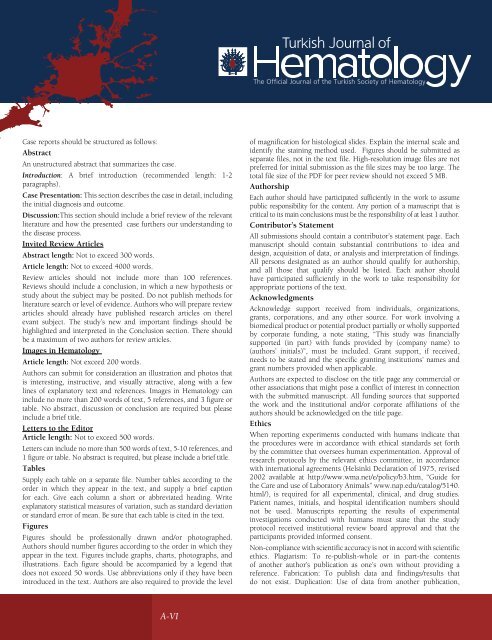Turkish Journal of Hematology Volume: 31 - Issue: 4
You also want an ePaper? Increase the reach of your titles
YUMPU automatically turns print PDFs into web optimized ePapers that Google loves.
Case reports should be structured as follows:<br />
Abstract<br />
An unstructured abstract that summarizes the case.<br />
Introduction: A brief introduction (recommended length: 1-2<br />
paragraphs).<br />
Case Presentation: This section describes the case in detail, including<br />
the initial diagnosis and outcome.<br />
Discussion:This section should include a brief review <strong>of</strong> the relevant<br />
literature and how the presented case furthers our understanding to<br />
the disease process.<br />
Invited Review Articles<br />
Abstract length: Not to exceed 300 words.<br />
Article length: Not to exceed 4000 words.<br />
Review articles should not include more than 100 references.<br />
Reviews should include a conclusion, in which a new hypothesis or<br />
study about the subject may be posited. Do not publish methods for<br />
literature search or level <strong>of</strong> evidence. Authors who will prepare review<br />
articles should already have published research articles on therel<br />
evant subject. The study’s new and important findings should be<br />
highlighted and interpreted in the Conclusion section. There should<br />
be a maximum <strong>of</strong> two authors for review articles.<br />
Images in <strong>Hematology</strong><br />
Article length: Not exceed 200 words.<br />
Authors can submit for consideration an illustration and photos that<br />
is interesting, instructive, and visually attractive, along with a few<br />
lines <strong>of</strong> explanatory text and references. Images in <strong>Hematology</strong> can<br />
include no more than 200 words <strong>of</strong> text, 5 references, and 3 figure or<br />
table. No abstract, discussion or conclusion are required but please<br />
include a brief title.<br />
Letters to the Editor<br />
Article length: Not to exceed 500 words.<br />
Letters can include no more than 500 words <strong>of</strong> text, 5-10 references, and<br />
1 figure or table. No abstract is required, but please include a brief title.<br />
Tables<br />
Supply each table on a separate file. Number tables according to the<br />
order in which they appear in the text, and supply a brief caption<br />
for each. Give each column a short or abbreviated heading. Write<br />
explanatory statistical measures <strong>of</strong> variation, such as standard deviation<br />
or standard error <strong>of</strong> mean. Be sure that each table is cited in the text.<br />
Figures<br />
Figures should be pr<strong>of</strong>essionally drawn and/or photographed.<br />
Authors should number figures according to the order in which they<br />
appear in the text. Figures include graphs, charts, photographs, and<br />
illustrations. Each figure should be accompanied by a legend that<br />
does not exceed 50 words. Use abbreviations only if they have been<br />
introduced in the text. Authors are also required to provide the level<br />
<strong>of</strong> magnification for histological slides. Explain the internal scale and<br />
identify the staining method used. Figures should be submitted as<br />
separate files, not in the text file. High-resolution image files are not<br />
preferred for initial submission as the file sizes may be too large. The<br />
total file size <strong>of</strong> the PDF for peer review should not exceed 5 MB.<br />
Authorship<br />
Each author should have participated sufficiently in the work to assume<br />
public responsibility for the content. Any portion <strong>of</strong> a manuscript that is<br />
critical to its main conclusions must be the responsibility <strong>of</strong> at least 1 author.<br />
Contributor’s Statement<br />
All submissions should contain a contributor’s statement page. Each<br />
manuscript should contain substantial contributions to idea and<br />
design, acquisition <strong>of</strong> data, or analysis and interpretation <strong>of</strong> findings.<br />
All persons designated as an author should qualify for authorship,<br />
and all those that qualify should be listed. Each author should<br />
have participated sufficiently in the work to take responsibility for<br />
appropriate portions <strong>of</strong> the text.<br />
Acknowledgments<br />
Acknowledge support received from individuals, organizations,<br />
grants, corporations, and any other source. For work involving a<br />
biomedical product or potential product partially or wholly supported<br />
by corporate funding, a note stating, “This study was financially<br />
supported (in part) with funds provided by (company name) to<br />
(authors’ initials)”, must be included. Grant support, if received,<br />
needs to be stated and the specific granting institutions’ names and<br />
grant numbers provided when applicable.<br />
Authors are expected to disclose on the title page any commercial or<br />
other associations that might pose a conflict <strong>of</strong> interest in connection<br />
with the submitted manuscript. All funding sources that supported<br />
the work and the institutional and/or corporate affiliations <strong>of</strong> the<br />
authors should be acknowledged on the title page.<br />
Ethics<br />
When reporting experiments conducted with humans indicate that<br />
the procedures were in accordance with ethical standards set forth<br />
by the committee that oversees human experimentation. Approval <strong>of</strong><br />
research protocols by the relevant ethics committee, in accordance<br />
with international agreements (Helsinki Declaration <strong>of</strong> 1975, revised<br />
2002 available at http://www.wma.net/e/policy/b3.htm, “Guide for<br />
the Care and use <strong>of</strong> Laboratory Animals” www.nap.edu/catalog/5140.<br />
html/), is required for all experimental, clinical, and drug studies.<br />
Patient names, initials, and hospital identification numbers should<br />
not be used. Manuscripts reporting the results <strong>of</strong> experimental<br />
investigations conducted with humans must state that the study<br />
protocol received institutional review board approval and that the<br />
participants provided informed consent.<br />
Non-compliance with scientific accuracy is not in accord with scientific<br />
ethics. Plagiarism: To re-publish-whole or in part-the contents<br />
<strong>of</strong> another author’s publication as one’s own without providing a<br />
reference. Fabrication: To publish data and findings/results that<br />
do not exist. Duplication: Use <strong>of</strong> data from another publication,<br />
A-VI

















